

In Gothic architecture, a wimperg is a gable-like crowning over portals and windows [1] and is also called an ornamental gable. Outside of immediate architecture, the wimperg is also found as a motif in Gothic carving. [2]


In Gothic architecture, a wimperg is a gable-like crowning over portals and windows [1] and is also called an ornamental gable. Outside of immediate architecture, the wimperg is also found as a motif in Gothic carving. [2]
The word has been documented in German since the 10th century (Old High German wintberga, Middle High German wintberge). The original meaning was "that which protects against the wind, conceals [birgt in German]". What was originally meant were gable parts that protrude above the roof. [3] In this context, Wintberge is also found in older sources in the meaning "merlon" ( [3] mentions Middle High German wintburgelin "merlon"), occasionally also "Wimperg" as "tooth-like top extension to the parapet wall of a battlement". [4]
The wimperg is considered an architectural element which, as an ornamental gable, reinforces the Gothic style's drive for height. [4] It can be flanked, framed or even occupied by pinnacles. The gable slopes of the wimperg were often framed or occupied with crockets. Its gable peak is often executed as a gable flower, [5] for example as a cruciform ornament. In German, the name Frauenschuh ("women's shoe") has been handed down for wimpergs with a tip that overhangs to the front. [5] The gable field may be left plain, but it is often filled with pre-faced or openwork tracery. [4]
The wimperg has also made it into some coats of arms as part of a heraldic figure. Predominantly, the architectural object is used to place a coat of arms in the free space under the legs for filling and ornamentation. For heraldry, it is more important that it is represented in the coat of arms. The building part in the coat of arms is mentioned in the blazon and should then also be appropriately acknowledged by the coat of arms' painter. A good example is the coat of arms of the town of Kamenz. Here, according to the description of the coat of arms, there is a golden wimperg decorated with crockets on a golden battlement wall. Often the wimperg is described as a "triangular gable", and it does not always have to be flanked by crockets or have a finial on top. The number of coats of arms with a wimperg remains manageable. In the description of the coat of arms of Fehrbellin before 1993, one could read of the quatrefoil in the wimperg. [6]

A spire is a tall, slender, pointed structure on top of a roof of a building or tower, especially at the summit of church steeples. A spire may have a square, circular, or polygonal plan, with a roughly conical or pyramidal shape. Spires are typically made of stonework or brickwork, or else of timber structures with metal cladding, ceramic tiling, roof shingles, or slates on the exterior.

A pinnacle is an architectural element originally forming the cap or crown of a buttress or small turret, but afterwards used on parapets at the corners of towers and in many other situations. The pinnacle looks like a small spire. It was mainly used in Gothic architecture.

The coat of arms of Germany displays a black eagle with a red beak, a red tongue and red feet on a golden field, which is blazoned: Or, an eagle displayed sable beaked langued and membered gules. This is the Bundesadler, formerly known as Reichsadler. It is one of the oldest coats of arms in the world, and today the oldest national symbol used in Europe.
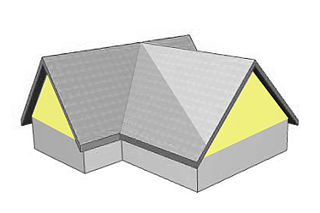
A gable is the generally triangular portion of a wall between the edges of intersecting roof pitches. The shape of the gable and how it is detailed depends on the structural system used, which reflects climate, material availability, and aesthetic concerns. The term gable wall or gable end more commonly refers to the entire wall, including the gable and the wall below it. Some types of roof do not have a gable. One common type of roof with gables, the gable roof, is named after its prominent gables.

The Cathedral of Saint Mary of Burgos is a Catholic church dedicated to the Virgin Mary located in the historical center of the Spanish city of Burgos. Its official name is Santa Iglesia Catedral Basílica Metropolitana de Santa María de Burgos.

A crocket is a small, independent decorative element common in Gothic architecture. The name derives from the diminutive of the French croc, meaning "hook", due to the resemblance of crockets to a bishop's crosier.

A flèche is the name given to spires in Gothic architecture. In French the word is applied to any spire, but in English it has the technical meaning of a spirelet or spike on the rooftop of a building. In particular, the spirelets often built atop the crossings of major churches in mediaeval French Gothic architecture are called flèches.
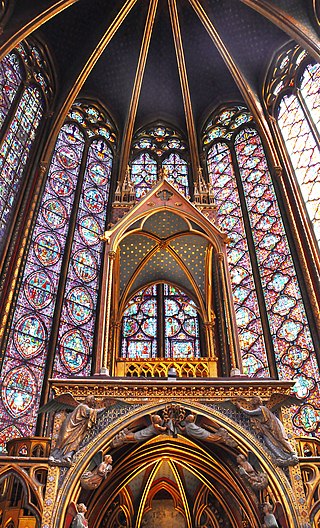
In French Gothic architecture, Rayonnant is the period from about the mid-13th century to mid-14th century. It was characterized by a shift away from the High Gothic search for increasingly large size toward more spatial unity, refined decoration, and additional and larger windows, which filled the space with light. Prominent features of Rayonnant include development of the rose window; more windows in the upper-level clerestory; the reduction of the importance of the transept; and larger openings on the ground floor to establish greater communication between the central vessel and the side aisles. Interior decoration increased, and the decorative motifs spread to the outside, to the facade and the buttresses utilizing great scale and spatial rationalism towards a greater concern for two-dimensional surfaces and the repetition of decorative motifs at different scales. The use of tracery gradually spread from the stained glass windows to areas of stonework, and to architectural features such as gables.
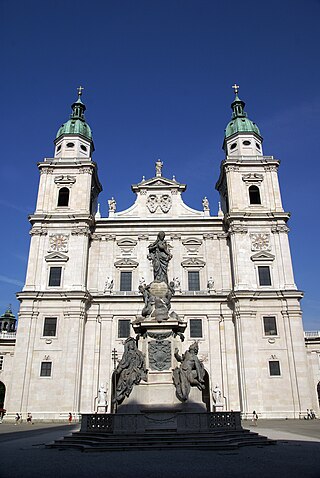
Salzburg Cathedral is the seventeenth-century Baroque cathedral of the Roman Catholic Archdiocese of Salzburg in the city of Salzburg, Austria, dedicated to Saint Rupert and Saint Vergilius. Saint Rupert founded the church in 774 on the remnants of a Roman town, and the cathedral was rebuilt in 1181 after a fire. In the seventeenth century, the cathedral was completely rebuilt in the Baroque style under Prince-Bishop Wolf Dietrich von Raitenau to its present appearance. Salzburg Cathedral still contains the baptismal font in which composer Wolfgang Amadeus Mozart was baptized.

Zell (Mosel) is a town in the Cochem-Zell district in Rhineland-Palatinate, Germany. Zell has roughly 4,300 inhabitants and is the seat of the like-named Verbandsgemeinde.
This page is a glossary of architecture.

The coat of arms of Bavaria has greater and lesser versions.
A fleuron is a flower-shaped ornament, and in architecture may have a number of meanings:

The Castle of Castro Marim is a medieval castle on a hilltop overlooking the civil parish of Castro Marim, in the municipality of the same name, in the Portuguese Algarve. The castle was part of the defensive line controlled by the Knights Templar, a stronghold used during the Portuguese Reconquista, and adapted during the Restoration War to defend the frontier.

Carl Moritz was a German architect and real-estate entrepreneur. Based in Cologne, he built the Cologne opera house of 1902, and various banks, theatres and churches in Germany.
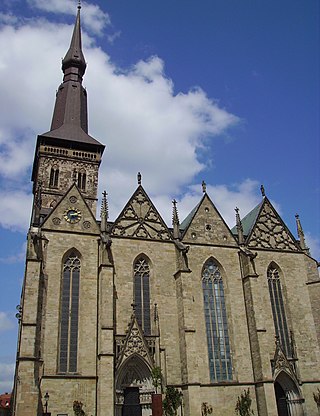
St. Marien is a Lutheran parish and market church in Osnabrück, Germany. It is one of the most artistically and historically significant buildings in the North German city. A previous Romanesque church was mentioned in records as early as 1177. However, the history of the church's construction began some time before it was first mentioned in writing. Archaeological traces suggest the existence of a predecessor building in the 10th century. Construction of the Gothic hall church which exists today started in the 13th century and was completed between 1430 and 1440.

The castle in Forchheim, also referred to as a royal palace or Kaiserpfalz, was an important urban castle under the bishops of Bamberg in the town of Forchheim in the south German state of Bavaria. The castle was built in the late 14th century. After comprehensive archaeological and architectural-historical investigation it has become one of the best researched castles of this period in Central Europe. Today it houses the Archaeological Museum of Upper Franconia.

A bifora is a type of window divided vertically in two openings by a small column or a mullion or a pilaster; the openings are topped by arches, round or pointed. Sometimes the bifora is framed by a further arch; the space between the two arches may be decorated with a coat of arms or a small circular opening (oculus).
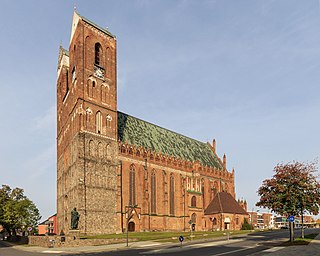
The Marienkirche in Prenzlau, Brandenburg, Germany, is the main Protestant parish church in the town, and is one of the most ornate churches of the Brick Gothic style in northern Germany. The church is a listed building.

Pedimental sculpture is a form of architectural sculpture designed for installation in the tympanum, the space enclosed by the architectural element called the pediment. Originally a feature of Ancient Greek architecture, pedimental sculpture started as a means to decorate a pediment in its simplest form: a low triangle, like a gable, above an horizontal base or entablature. However, as classical architecture developed from the basis of Ancient Greek and Roman architecture, the varieties of pedimental sculpture also developed. The sculpture can be either freestanding or relief sculpture, in which case it is attached to the back wall of the pediment. Harris in The Illustrated Dictionary of Historic Architecture defines pediment as "In classical architecture, the triangular gable end of the roof above the horizontal cornice, often filled with sculpture." Pediments can also be used to crown doors or windows.